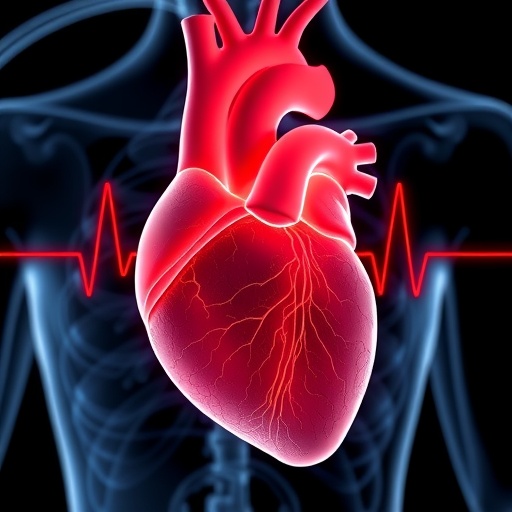In a remarkable leap forward for extracorporeal membrane oxygenation (ECMO) technology, a recent study published in BioMedical Engineering OnLine introduces a cutting-edge filter-type neural network algorithm designed to enhance counter-pulsation (CP) control in pulsatile ECMO systems. This breakthrough addresses a longstanding challenge in cardiovascular support devices: accurately distinguishing true heartbeats from the myriad of pulsatile signals generated within complex circulatory interventions. By refining heartbeat-pulse discrimination and synchronization accuracy, the new system promises to substantially improve patient outcomes in critical care settings where mechanical circulatory support is essential.
Extracorporeal membrane oxygenation is a well-established life-saving technique used in severe cardiac and pulmonary failure, providing oxygenation and circulatory support outside the body. Despite advances, conventional ECMO systems often face complications such as blood trauma, thrombosis, and inadequate synchronization with the patient’s heart rhythm. Pulsatile ECMO aims to mimic natural cardiac pulsatility, yet achieving seamless counter-pulsation—where the device pulses exactly out of phase with the heart to optimize hemodynamics—remains technically demanding. The key difficulty lies in recognizing genuine heartbeats from blood pressure signals that are distorted by ECMO’s own pulses, reflected waveforms, and motion artifacts.
The team behind this innovation, led by Jang HW and colleagues, has developed a cumulative algorithm leveraging filter-type neural networks to tackle these difficulties head-on. Neural networks, trained on patterns of true heartbeat waveforms versus false pulses, enable the system to parse complex oscillations in blood pressure data with unprecedented precision. This computational approach shines particularly in clinical scenarios where obtaining reliable electrocardiogram (ECG) signals is not feasible, such as in patients with arrhythmias or those with technical monitoring limitations.
.adsslot_oFDst6JP4R{ width:728px !important; height:90px !important; }
@media (max-width:1199px) { .adsslot_oFDst6JP4R{ width:468px !important; height:60px !important; } }
@media (max-width:767px) { .adsslot_oFDst6JP4R{ width:320px !important; height:50px !important; } }
ADVERTISEMENT
Integration of this algorithm into the pulsatile ECMO control system allowed for automated detection of heart rate and real-time adjustment of the ECMO pulsation timing to enforce counter-pulsation. The synchronization effect is vital: when the device’s pulse coincides with the heart’s relaxation phase, coronary perfusion and overall circulatory efficiency are maximized, reducing cardiac workload and improving oxygen delivery. Such refined control heralds a new era in mechanical support devices capable of harmonizing with the patient’s native cardiac rhythm rather than overriding it.
To validate their approach, the researchers employed a mock circulation system replicating human blood pressure waveforms generated by a sophisticated heart model. This experimental setup provided a controlled environment to simulate cardiac output and variable heart rates, allowing the team to rigorously test the neural network’s accuracy and responsiveness. Impressively, the filter-type neural network algorithm maintained impeccable counter-pulsation synchronization under stable heart rate conditions, confirming its robustness in idealized scenarios.
However, clinical realities often diverge from steady-state conditions. Addressing this, the study explored the system’s performance under heart rate variability by imposing fluctuations of ±5 beats per minute every minute. Here, the algorithm demonstrated a slight decline in synchronization success, dropping to a still-respectable 78.62%. This represents a substantial improvement over the mere 25.75% success observed in absence of any control mechanism. The results underscore both the promise and the remaining challenges in adapting real-time neural network algorithms to dynamically changing physiological states.
Interestingly, the researchers pinpointed a 0.48-second delay between heart rate detection and counter-pulsation control initiation as a limiting factor during sudden heart rate increases. This latency highlights the delicate balance between signal processing complexity and system responsiveness—a crucial consideration for future iterations aiming to operate flawlessly in urgent or unstable conditions. Reducing such controller delay could further elevate success rates in dynamic cardiac environments.
Beyond immediate clinical implications, this work heralds broader technological advances. The application of advanced neural networks in embedded medical devices exemplifies how artificial intelligence can augment traditional bioengineering solutions. The study’s methodology—combining computational intelligence with sophisticated physiological modeling—sets a precedent for future innovations across cardiovascular assistive devices, including ventricular assist devices (VADs) and implantable hemodynamic monitors.
Moreover, the algorithm’s design accounts not only for heartbeat discrimination but also for filtering out extraneous signals such as motion artifacts and wave reflections, common pitfalls in continuous blood pressure monitoring. This holistic approach ensures reliability which is particularly vital for ECMO patients who are often immobile and at risk for signal disturbances due to clinical interventions or patient movement.
Clinicians could foreseeably benefit from adopting this technology in critical and intensive care units, where timely and precise circulatory support decisions are paramount. Improved counter-pulsation control may translate into lower incidence of ECMO-related complications, better cardiac recovery trajectories, and ultimately, enhanced survival rates for patients reliant on extracorporeal life support.
Looking forward, the promising performance of the filter-type neural network invites further clinical trials involving human subjects to assess efficacy and safety in vivo. Integration with multi-parameter monitoring setups alongside ECG and echocardiography offers another frontier to enhance the algorithm’s contextual accuracy. Enhanced adaptive feedback mechanisms might allow the system to self-tune in response to diverse pathological conditions, from arrhythmias to septic shock-induced hemodynamic instability.
Furthermore, the modular nature of neural network architectures may allow customization for other pulsatile support devices or even for assistive technologies in wearable and implantable cardiac sensors, broadening the scope far beyond ECMO alone. As AI and biomedical engineering converge, such hybrid smart systems are poised to redefine personal cardiovascular medicine.
In summary, the innovative filter-type neural network outlined by Jang and team represents a transformative step in extracorporeal cardiac support. By surmounting long-standing barriers in heartbeat detection and synchronization amidst complex pulsatile circulatory signals, this technology opens pathways to safer, more efficient, and patient-friendly ECMO therapies. As pulsatile mechanical support devices gain traction, harnessing AI-driven control algorithms will likely become integral to optimizing hemodynamic coordination and improving life-saving treatments.
The study’s findings serve as both a technical milestone and an inspiring example of interdisciplinary synergy between neural computation and biomedical engineering. They illuminate a future where machine intelligence not only aids but enhances physiological function in acute medical care, emboldening clinicians and engineers alike to push the envelope of what mechanical circulatory assistance can accomplish.
Subject of Research: Counter-pulsation control in pulsatile ECMO systems using filter-type neural networks for heartbeat-pulse discrimination and synchronization accuracy.
Article Title: Filter-type neural network-based counter-pulsation control in pulsatile ECMO: improving heartbeat-pulse discrimination and synchronization accuracy.
Article References:
Jang, HW., Yoo, CY., Kang, SM. et al. Filter-type neural network-based counter-pulsation control in pulsatile ECMO: improving heartbeat-pulse discrimination and synchronization accuracy.
BioMed Eng OnLine 24, 83 (2025). https://doi.org/10.1186/s12938-025-01414-4
Image Credits: AI Generated
DOI: https://doi.org/10.1186/s12938-025-01414-4
Tags: BioMedical Engineering OnLine study findingscardiovascular support device advancementschallenges in mechanical circulatory supportcounter-pulsation control in pulsatile ECMOextracorporeal membrane oxygenation technologyheartbeat synchronization in ECMOheartbeat-pulse discrimination techniqueshemodynamic optimization in ECMOimproving patient outcomes in critical careneural network algorithm for ECMOpulsatile ECMO systemsreducing complications in ECMO





